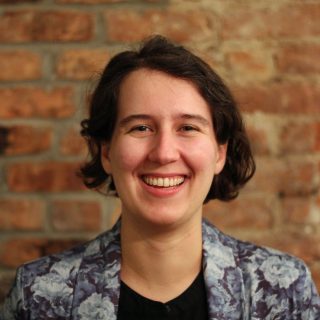
What I’m working on:
My biggest project right now is The Sick Times, a new nonprofit news site covering long COVID and related diseases that I co-founded with my friend Miles Griffis. We launched in November with a weekly newsletter, so I’ve been writing a couple of short articles and editing Miles’ pieces each week. Plus, we’re fundraising, managing social media, reporting future stories, collecting pitches and feedback from the long-COVID community, and more. Starting a new publication is a lot of work!
Outside of that, I’m working part-time for the Council for the Advancement of Science Writing (CASW) on Connector, an online library of science-writing resources, and Showcase, a site that highlights exceptional science stories. I’m also working on other freelance projects, which currently include an upcoming feature at Science News and research briefs for an academic center.
Where I work:
I live in Brooklyn, New York. My partner and I share a home office in our two-bedroom apartment, where she is very kind about hearing one side of my interviews. We also have a backyard—a rarity in NYC!—where I like to work when the weather is amenable. I often take phone calls there, because cell reception is better in the backyard. Despite the cold in recent weeks, I’ve been spending a lot of time out there, because we recently adopted a puppy and are training him to do his business outside.
Daily routine:
I usually get up around 7:00 a.m. and start my day with something active—a run, a walk, or some stretching. Then I make breakfast and do a bit of tidying in the kitchen while listening to WNYC, the local NPR station. I have contributed a few stories to the shared Gothamist/WNYC newsroom, and once or twice, unexpectedly heard myself on the radio during this morning routine!
After eating, checking emails, and taking the dog outside, I get going on work around 9:30 or 10:00 a.m. Depending on the day, I might have a couple of calls—interviews with scientists, meetings with colleagues about projects. Or I might be working—writing, editing, analyzing data, managing projects, developing pitches—uninterrupted until lunch, around 1:00 or 2:00 p.m. Then, the same goes for the afternoon. I personally like days when I have one or two calls best, because I find I’m most productive when I have to fit the work into specific time windows.
I stop work sometime between 5:00 and 7:00 p.m., depending on what I’m doing that evening. Last summer, I joined a weightlifting gym that has group sessions at 5:00 p.m. and 6:30 p.m. on weekdays, so I’ll take off earlier if I’m going to a 5:00 p.m. session. On other days, I’ll head to band practice or a political action: I play in an activist marching band that is frequently invited to rallies, marches, picket lines, and other events around the city. For me, one advantage of freelancing is a flexible schedule that allows me to support the occasional mid-workday rally, though most of our events are on evenings and weekends.
Later in the evening, if I have the energy, I might spend another hour or two writing or catching up on emails. Except for Fridays, which are reserved for date night with my partner—going out to dinner or watching a movie!
Most productive part of my day:
The few hours between breakfast (when my morning caffeine kicks in) and lunch are often very productive for me. It’s a good time to turn off notifications, put on an instrumental album, and get some writing done. Sometimes I get distracted by emails, though, and the time seems to just disintegrate. Late evenings can also be productive if I’m scrambling to make a deadline.
Most essential ritual or habit:
Going outside regularly—ideally first thing in the morning—is really crucial for me. The fresh air helps me wake up and turn my brain on just as much as a cup of tea or coffee. My routines for exercising and playing music are also important, as they give me space during the week to get out of my apartment and not think about work.

Favorite note-taking techniques/tools:
Mostly a lot of Google Docs. I start a personal notes doc for every project, from the shortest news story to the biggest data analysis project, and label them in a consistent style (“[organization/outlet] – [title] – notes”) so that I can easily find them later. I also have a physical notebook that I use occasionally for in-person reporting or drafting; I find writing longhand helpful when I’m stuck on a story. MUJI is my brand of choice for notebooks and pens.
How I keep track of my to-do list:
I have an old-school to-do list drafted on a whiteboard in my office. Every morning, I update the list, then I check items off throughout the day. The whiteboard is a keepsake from the only in-person office I ever worked in, when I was on staff at Stacker—the company ended its lease at a WeWork at the beginning of 2020 and let us staffers split up the office supplies. (I was working from home for just a couple months before the rest of the world!) Along with the whiteboard, I have a handful of sticky notes around my computer and a running list of important deadlines taped above my desk.
Essential software/apps/productivity tools:
Slack and Google Docs are the two tools I use most frequently. While I’m not required to be on Slack for a staff job, I am in quite a few networking workspaces! And we have a workspace for The Sick Times, which I mostly use to message Miles and send myself reminders. I also have Google Calendar open all day to make sure I don’t miss any meetings.
Favorite time waster/procrastination habit:
Talking to my partner is a frequent source of distraction throughout the workday, though I wouldn’t call it a waste of time. We have enough similarities in our jobs (she works in book publishing) that we can complain to each other in great detail when annoyances happen—so we often have to remind each other to actually get back to work once we start talking. Our puppy, Jack-o’-Lantern, has frequently distracted me in the last few weeks, too, mostly by trying to eat random items around the apartment. Social media is also a big way for me to procrastinate, of course, though I feel that I’ve been better with it since deleting the app formerly known as Twitter off my phone in the fall.
My reading habits:
Primarily, I read a lot of email newsletters. As someone who has written newsletters for over three years, I’m a big fan of the format. And I strive for “inbox zero,” so I always at least open every newsletter that I receive. I regularly read some of the big science and health newsletters (Politico’s Pulse, KFF Health News’s Morning Briefing, STAT’s Morning Rounds, etc.) and read articles that they promote, along with other daily news roundups and independent newsletters, like Today in Tabs and How Things Work.
But my favorite newsletter throughout last year was a Substack called Les Mis Letters, which delivered one chapter of the novel Les Misérables to my inbox every day. The famously long book has 365 chapters and is in the public domain, making it perfect for a Substack in the vein of other literature newsletters like Dracula Daily. I successfully completed the novel, along with hundreds of others who read along via email and shared analysis with other readers; it was a fun communal experience.
Outside the newsletters, I read fiction and nonfiction books—alternating between fiction (sci-fi, romance, literary novels) and nonfiction (usually science). This has apparently been a period of dense fiction for me, as I’ve been working on the Dune series—I just got the fifth book out of the library.
Sleep schedule:
I typically get to bed between 11:00 p.m. and 12:00 a.m., aiming to get seven to eight hours of sleep on weekdays and nine hours on weekends.


